Effective Strategies to Prevent Ant Infestations
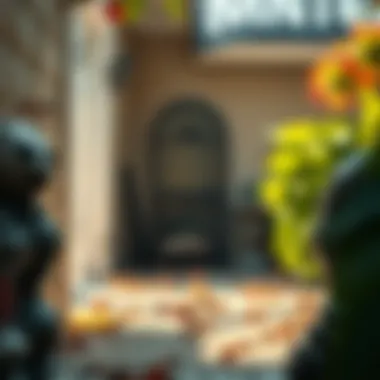

Intro
Ants can be a nuisance for any homeowner. They're not just tiny creatures scurrying about; they can infiltrate your home without you even realizing it. Understanding how to manage these pests means knowing about their habits, entry points, and, importantly, prevention strategies you can implement. This guide is designed to arm you with insights, making sure your home stays an ant-free sanctuary.
Pest Identification
When it comes to managing pests, the first step is identifying who you're dealing with. Ants are a diverse group, with over 12,000 species worldwide, but only a handful commonly invade homes. Here are a few key players:
Common Ant Species
- Argentine Ant: Small and light brown, these ants form large colonies and can be hard to eradicate.
- Odorous House Ant: Known for the distinct smell they emit when crushed, these ants often nest in walls.
- Carpenter Ant: These larger fellows can cause structural damage by hollowing out wood for nesting.
Signs and Symptoms of Infestation
Recognizing an ant issue requires being alert to several signs:
- Visible Trails: Ants typically follow scent trails. Spotting groups of ants leading to food sources hints at a larger problem.
- Nesting Locations: Look for nests in warm, hidden areas such as under rocks or alongside trees close to your home.
- Damage: Especially with carpenter ants, look for sawdust or frass near wood structures.
"Ants may be tiny, but their colonies can swiftly burgeon into large infestations if left unchecked."
Prevention Strategies
Once you’ve identified the pests plaguing your home, the next step is prevention. This involves a mix of home maintenance and strategic deterrents:
Home Maintenance Tips
- Seal Entry Points: Use caulk to seal cracks and crevices in walls and windows.
- Clean Up Crumbs: Regularly sweep and vacuum to eliminate food sources, keeping countertops and floors spotless.
- Proper Food Storage: Store food in airtight containers; not just for ants but for rodents and other pests as well.
- Maintain Yard: Keep shrubs trimmed and create a distance between plants and your home's foundation. This maintains a natural barrier.
Natural Deterrents and Barriers
There are plenty of natural options that deter ants without harmful chemicals:
- Vinegar Solution: Mix equal parts of vinegar and water, spraying it on ant trails effectively disrupts their scent markers.
- Cinnamon and Peppermint: Sprinkle these aromatic spices near potential entry points; ants dislike the strong scent.
- Diatomaceous Earth: This natural powder can be applied around nesting areas. It is harmless to pets and children but can eliminate ants by damaging their exoskeleton.
Treatment Options
If prevention efforts fall short, treatment may be necessary. Here’s a look at various approaches:
Overview of Chemical vs. Natural Treatments
Chemical treatments are potent but may impact other wildlife and pets. In contrast, natural solutions often require more application but are safer. Think about what fits your needs best:
Step-by-Step Guides for DIY Treatments
For a Natural Ant Bait:
- Mix 1 part sugar with 1 part boric acid.
- Add water to create a paste.
- Place it where ants frequent, but keep away from children and pets.
- Monitor and reapply as needed.
For Using Diatomaceous Earth:
- Apply powder in areas where ants are seen.
- Make sure it stays dry, since moisture nullifies its effectiveness.
Stay prepared, and your home can remain a peaceful haven.
Understanding Ant Behavior
Understanding ant behavior is a cornerstone for effective pest control in homes. Recognizing why ants invade, how they operate, and their needs can transform your approach from reactive measures to proactive strategies. It’s not just about keeping the tiny invaders out; it’s about learning their patterns and habits to stay a step ahead.
The Social Structure of Ant Colonies
Ants live in structured communities known as colonies, where each member has a role. The hierarchy usually consists of:
- Queen: The primary reproducer within the colony, she lays thousands of eggs. Without her, the colony often fails to thrive.
- Workers: These are the gatherers, builders, and defenders. They forge for food, construct nests, and take care of the queen's offspring.
- Drones: Their sole purpose is to mate with the queen. After mating, they typically die soon after.
This social arrangement allows ants to operate with astonishing efficiency. When one ant finds food, it releases pheromones to lead others—a behavior that underscores their communal nature. Knowing this allows homeowners to anticipate invasion paths based on the foraging trails that ants develop.
Common Ant Species in Homes
Ants may be tiny, but the variety is vast. Here are some of the more commonly encountered species:
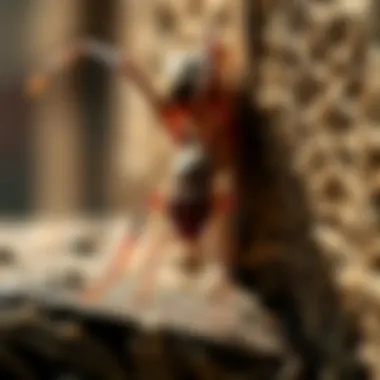
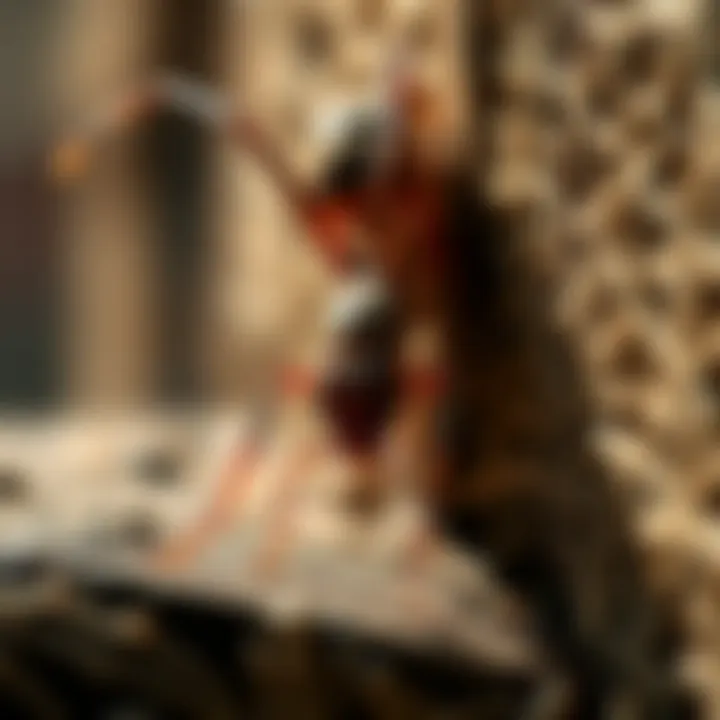
- Carpenter Ants: Often found in damp, decaying wood, they create nests by hollowing it out, which can damage the structure of your home.
- Odorous House Ants: Named for their distinct smell when crushed, they often invade homes in search of sugary foods.
- Pavement Ants: These ants like to nest under sidewalks and driveways but will venture indoors for food, making them a common nuisance.
By identifying which species have invaded your space, you can tailor your prevention strategies accordingly.
Life Cycle of Ants
Understanding the life cycle of ants can demystify their rapid invasions. The cycle consists of several stages:
- Egg: The queen lays eggs, which typically hatch into larvae in a matter of days.
- Larva: Larvae are fed and cared for by worker ants, eating protein-rich diets until they pupate.
- Pupa: This is a transformative stage where larvae develop into adult ants. The duration can vary, taking days to weeks.
- Adult: Once mature, they take on roles in the colony, contributing to its survival.
"Ant life cycles are so short; a new colony can spring up in the blink of an eye. This knowledge emphasizes the need for early intervention."
By bearing in mind the life cycle stages, homeowners understand timing for effective control measures. Early detection can be key to preventing an infestation.
Understanding these behaviors and structures gives you not just insight but also a more nuanced approach to keeping your home ant-free.
Identifying Entry Points
Identifying how ants are getting into your home is crucial for keeping them out. Understanding entry points allows homeowners to take proactive measures. Ignoring this aspect can lead to ongoing infestations, which can quickly escalate into significant problems. By focusing on these specific elements, you'll not only be protecting your space but also making your living environment more comfortable and hygienic.
Common Areas of Ant Entry
Ants are resourceful creatures, often finding ways to slip into your home unnoticed. They tend to favor certain pathways that you might overlook. Here’s a rundown of the most common places to keep an eye on:
- Window Frames: Check for gaps or wear around your windows. Dirt can accumulate, making it a perfect entryway for ants.
- Doors: Bottoms and sides of doors can harbor cracks or spaces. Weather stripping may wear down over time.
- Foundation Cracks: Even tiny fissures in your home’s foundation can serve as highways for ants. Inspect regularly, especially in older homes.
- Utility Lines: Pipes and cables that enter your domicile can create avenues for ants. Ensure these areas are sealed properly.
- Vents: Both dryer and air conditioning vents should be screened well. Ants may be attracted to the warmth or moisture that escapes.
If you've spotted ants inside, trace back their path and focus on these common entry areas.
Inspecting Your Home for Vulnerabilities
A thorough inspection of your home helps outline where ants may be sneaking in. Here are steps to highlight potential vulnerabilities:
- Visual Inspection: Walk around your home, both inside and out. Look for signs of ant activity, such as trails of ants or discarded wings.
- Check for Moisture: Ants are attracted to moisture. Look for leaks or damp spots near plumbing or in your basement.
- Inspect the Kitchen: Kitchen areas need special attention. Food crumbs or spills are inviting, so consider where ants might get food—especially near pet bowls.
- Take Note of Landscaping: Overgrown shrubs or mulch may provide a bridge for ants into your home. Keep landscaping trimmed and away from your walls.
Always remember, the earlier you catch these vulnerabilities, the easier it is to address the issue.
Sealing Cracks and Gaps
Once you’ve identified entry points, the next step is to seal them up. Here are practical methods to consider for fortifying your home:
- Caulk: Use a high-quality caulk for sealing cracks and gaps, particularly around windows, doors, and foundation joints.
- Weather Stripping: Install or replace weather stripping on doors to create a tight seal. This not only keeps ants out but can also improve energy efficiency.
- Screening Vents: Ensure that vent holders are tightly packed with mesh screens to keep pests from coming in.
- Use Fillers: For larger breaches in your foundation or walls, consider using expanding foam or concrete sealers.
By sealing these entry points effectively, you significantly diminish the likelihood of ants entering your home. It's a straightforward way to address a problem that can quickly spiral out of control.
“An ounce of prevention is worth a pound of cure.” By identifying and sealing entry points, you're investing in long-term peace of mind for your household.
Now that you have pointers on identifying and sealing entry points, you can take proactive measures to keep your home ant-free.
Preventive Measures
Preventive measures are the cornerstone of a good defense against ants infiltrating your home. Taking proactive steps can not only keep these pests at bay but also foster a clean, healthy living environment. A stitch in time saves nine; this old saying rings true when we consider that a small effort today can prevent a colossal infestation tomorrow. Preventing an ant invasion is much simpler and less costly than dealing with the aftermath of one.
Maintaining Cleanliness
When it comes to keeping ants away, cleanliness is non-negotiable. It's as though ants possess an uncanny radar for crumbs and spills. A dirty kitchen, with leftover sauces and spilled sugar, becomes a beacon, calling forth a line of marching ants. Regularly sweeping and mopping floors is essential. Don’t neglect those hard-to-reach spots; crumbs tend to take residence in the most obscure places.
- Wipe down surfaces daily with a mix of water and vinegar to remove traces of food and reduce odors that might attract ants.
- Always remember to empty trash bins regularly and keep lids secured. Ants can turn a garbage can into a banquet table if the lid is off, so keep it tight!
A clean home not only discourages ants but also promotes overall hygiene, reducing the risk of other pests and diseases.
Proper Food Storage
Food storage is paramount in the battle against ants. Any unsealed food item can attract these persistent pests akin to moths to a flame. Storing food correctly isn’t just about convenience; it's about safeguarding your home and personal space.
- Use airtight containers for all pantry items. This isn’t just for preserving freshness; it’s a formidable barrier to ants.
- Avoid leaving pet food out for long periods. If your furry friend has leftovers, consider investing in pet bowls with lids to keep ants from making a new home there.
Additionally, keep a close watch on open containers in your fridge. An uncovered plate can become an ant’s dream destination.
Managing Outdoor Areas
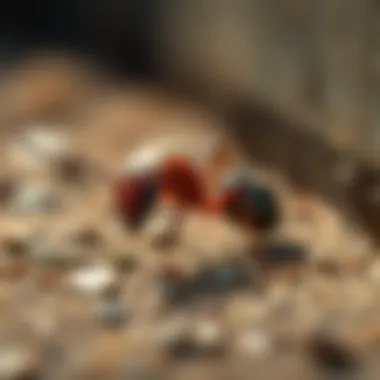
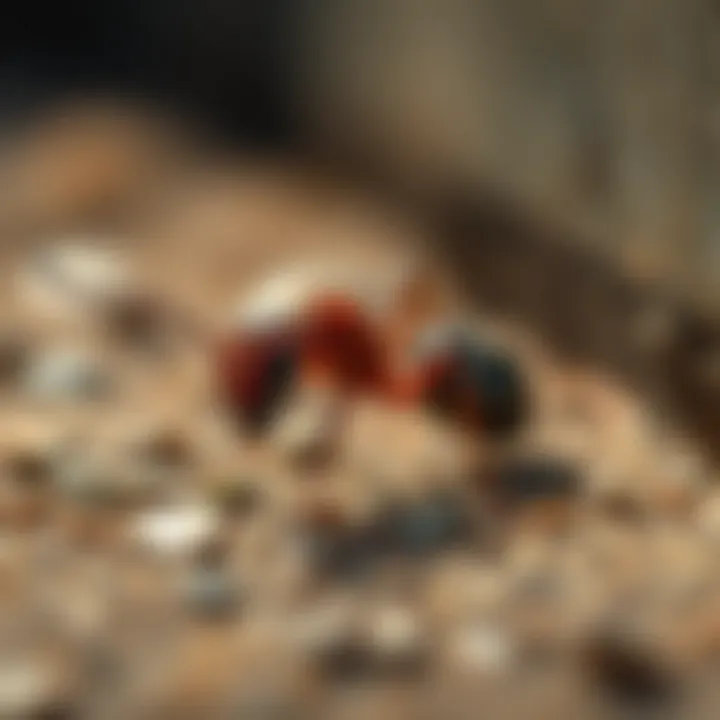
The outside of your home is just as important as the inside when it comes to deterring ants. Think of your outdoor space as the first line of defense against an army of ants. Managing your yard can significantly reduce their chances of entering your home.
- Trim back shrubs and trees that touch the house; ants often use branches as highways to your windows and roof.
- Make sure firewood is stored at least 20 feet away from your house and off the ground. This avoids attracting ants looking for nesting sites.
- Regularly remove any debris, like fallen branches, leaves, and grass clippings, that may create nesting sites close to your home.
By implementing these preventive measures, you can significantly reduce the likelihood of an ant invasion, giving you peace of mind in your living space. Whether it’s keeping your kitchen pristine or managing outdoor habitats, every little bit helps in this ongoing battle with nature.
Natural Deterrents
Keeping unwanted ants at bay can be a tough nut to crack, but using natural deterrents might just be the ace up your sleeve. These options not only offer a more environmentally friendly approach but also pose less risk to children and pets compared to some chemical alternatives. Understanding what natural deterrents work and how to use them effectively is key in creating a fortress against these tiny invaders.
Essential Oils and Their Efficacy
Essential oils have gained ground as potent allies in the war against ants. Many homeowners find these fragrant oils effective, and they offer multiple benefits. Peppermint oil, for instance, is not only a delight for the nose but is actually offensive to ants. You can mix a few drops with water in a spray bottle and target the ants’ trails or nests.
"Ants rely heavily on pheromones to communicate; disrupting these signals with essential oils can deter their movement and nesting."
You might also want to consider tea tree oil and lemon oil, both of which boast similar qualities. Just remember that while essential oils can deter ants, their efficacy can vary with concentration and application. Use them generously to ensure they’re effective. Plus, they double as mood enhancers for you while you’re at it!
Vinegar Solutions
Ever tried a good old vinegar solution? This kitchen staple does wonders when combined with water at a 1:1 ratio. Ants find the smell of vinegar confusing, masking those pheromone trails that they so heavily rely on. Give your countertops or any entry points a spritz, and watch those ants think twice about waltzing into your home.
You can even soak cotton balls in a vinegar solution and place them strategically near likely entryways. Not only does it serve to deter ants, but it also keeps your home smelling fresh without synthetic fragrances. A simple yet effective tactic could save you from a creeping army.
Homemade Ant Barriers
Creating homemade ant barriers is another resourceful method to stop ants in their tracks. Simple ingredients lying around your house can serve as formidable barriers. For example, a mixture of baking soda with sugar forms a bait that’s both tempting and deadly for ants. They say not to mix sweet and salty, but in this case, the sweet bait lures them in, while the baking soda does the dirty work.
Another option involves using diatomaceous earth. Sprinkling it around the perimeter of your house or where ants are most active can be quite effective. It works by dehydrating ants as they pass through it, making it a non-toxic yet ruthless deterrent.
With a little trial and error, you can find the perfect natural deterrent or a combination that fits your needs. The bonus is a thoughtfully maintained home, free of pesky ants, without the need for harsh chemicals.
Chemical Solutions
Chemical solutions play a crucial role in the ongoing battle against ant infestations in homes. While preventive measures and natural deterrents can certainly help, when the situation escalates, these robust methods provide targeted intervention. Understanding how to effectively utilize chemical solutions can be the difference between a peaceful home and one overrun by these industrious pests. It's important not only to consider the effectiveness of these solutions but also their application limitations and safety measures that should accompany their use.
Types of Ant Baits
Ant baits are a favored choice for many homeowners, largely due to their ease of use and effectiveness. These baits typically contain a mixture of poison and attractants that lure ants in, allowing them to carry the toxin back to their colonies. Some common types of ant baits include:
- Gel Baits: These are easy to apply and can be placed in cracks and crevices. They usually attract a wide variety of ant species.
- Granular Baits: They can be sprinkled around the perimeter of your home or in areas with heavy ant traffic. Many people find them useful for outdoor use as well.
- Liquid Baits: Similar to gel baits, but often more effective in wet conditions since the liquid formulation can penetrate better into the nests.
Each type has its own merits, so it’s wise to assess the specific ant problem before choosing a bait. Additionally, bait placement is key; placing them in locations where ants frequently travel enhances their effectiveness.
Insecticides: Pros and Cons
Insecticides can be a double-edged sword. While they offer immediate results for controlling ant populations, their use comes with notable pros and cons.
- Pros:
- Cons:
- Immediate Action: Many insecticides kill ants on contact, providing quick relief.
- Variety of Forms: From sprays to dusts, insecticides come in different forms, allowing users to choose based on their comfort and the specific environment.
- Broad-Spectrum: Some insecticides target not just ants, but other household pests as well.
- Health Concerns: Chemicals can pose risks to pets and children, especially if used carelessly.
- Environmental Impact: Persistent chemical residues can affect local wildlife and ecosystems if proper care isn’t taken, leading to unintended consequences.
- Ant Resistance: Overuse can lead to ants developing resistance to certain chemicals, necessitating a change in strategy over time.
Safety Precautions When Using Chemicals
The effectiveness of chemical solutions shouldn't overshadow safety practices. By adhering to basic safety guidelines, homeowners can mitigate risks. Some vital precautions include:
- Read Labels Carefully: Always follow the manufacturer's instructions regarding application and safety.
- Use Protective Gear: Gloves and masks aren't just for show; they protect your skin and lungs from exposure.
- Keep Away from Children and Pets: Ensure that treated areas are inaccessible to young ones and furry friends until safe.
- Ventilation: If applying indoors, maintain good airflow by opening windows and doors.
- Dispose Responsibly: Follow local guidelines for disposal to prevent environmental damage.
"Using chemicals without care can lead to more problems than it solves. Always prioritize safety!"
By implementing these strategies and recommendations, it's possible to successfully manage ant populations while minimizing risks associated with chemical solutions. Combining methods can lead to more long-lasting and effective results in keeping homes free of unwanted ants.
Monitoring and Follow-Up
Keeping ants at bay is no small feat, and the journey doesn’t end after you’ve put preventive measures in place. Monitoring and follow-up are critical to ensuring that your efforts are effective. Regularly checking for signs of ants and adjusting your strategies based on what you discover can make all the difference in maintaining an ant-free home. This ongoing vigilance not only helps to catch any new infestations before they bloom but also enables you to fine-tune your tactics to create the most welcoming atmosphere for you and the least hospitable environment for ants.
Regular Inspection Techniques


A proactive approach is key to successful ant control. Consider adopting the following inspection techniques:
- Routine walkthroughs: Schedule a walk-through of your home at least once a month. Pay close attention to commonly infested areas such as the kitchen, pantry, and utility spaces. Look for trails, droppings, or any signs of nests.
- Sticky traps: These can be placed in strategic spots such as under sinks or near suspected entry points. They help to catch wandering ants and provide visual confirmation of activity levels.
- Dusting powder: Apply a light dusting of talcum powder or diatomaceous earth in secluded corners or around entry points. The fine particles can reveal potential ant traffic based on how disturbed they are over time.
Regular inspections create an opportunity to not only spot problems early but also learn more about the ants that might be infiltrating your home.
Adjusting Strategies Based on Results
Once you've conducted your inspections, it’s crucial to adjust your strategies according to the results. There is no one-size-fits-all when it comes to ant control; instead, adaptability is the name of the game. Consider these adjustments based on your findings:
- Increased baiting: If you notice more ant traffic in certain areas, you might need to increase the number of traps or bait stations. Target the zones with high activity to break their line of communication.
- Reevaluate cleaning protocols: Sticking to a cleaning schedule is vital, but if ant presence persists, consider switching cleaning products. Some commercial cleaners might be masking food particles without fully eliminating ant scents.
- Enhance sealing efforts: If ants are still entering, check your sealing work again. Tiny cracks that you assumed were secure may still be loose. Re-seal or apply barriers as necessary.
Adjusting your strategies based on what you observe will enhance your long-term success in thwarting these pests.
When to Seek Professional Help
Despite your best efforts, there may come a time when it becomes clear that the ant situation is not manageable on your own. Recognizing when to call in the pros is as important as any preventive measure.
- Persistent infestations: If after multiple attempts to manage the problem the ants keep making a comeback, it might be time to consult a pest control professional. They possess deeper knowledge of ant behavior and advanced tools to tackle infestations effectively.
- Structural concerns: If you notice signs that ants are nesting inside walls or other structures, professional intervention is often necessary to treat these areas properly. They might require specific treatments that aren’t available to everyday homeowners.
- Chemical application knowledge: Pest control experts understand how to apply insecticides safely around your home to minimize risk to children and pets.
It’s better to call in a professional service than to risk further complications that may arise from a persistent ant colony.
Remember: Regular monitoring and timely adjustments can save you from large infestations later. Your dedication to this process not only protects your home but also helps cultivate a safe and comfortable living space for you and your family.
Debunking Common Myths
When it comes to ants, there's no shortage of beliefs floating around. Some might say these little critters are harmless, while others will insist that a clean home will always keep them away. Debunking these myths is crucial in understanding how to effectively deal with ant problems in your home. Misunderstandings about ant behavior and how to prevent infestations can lead to ineffectiveness in pest control strategies. By dispelling these common myths, you’ll be better equipped to make informed decisions to keep your living space ant-free.
Myths About Ants and Sanitation
One of the biggest misconceptions is that a dirty home is the sole reason ants invade. Many people believe that if they maintain cleanliness, there’s no chance of an ant problem. However, this isn't entirely true. While sanitation plays a significant role in ant prevention, other factors also attract these pests. Ants are opportunists, and they can find their way into even the tidiest of homes.
Consider this:
- Food Sources: Ants are drawn by food aromas, including pet food, sugar spills, and even grease from cooking. Each can lure them into your home, regardless of how clean the surroundings are.
- Shelter: Cracks in walls or barely sealed windows can invite ants in. They often seek shelter from outdoor elements as well.
Misconceptions About Natural Remedies
Homeowners often turn to natural remedies to handle ant invasions, believing that these solutions are akin to a magic bullet. While natural deterrents can be helpful, relying solely on these may not yield the desired results. Some common myths include:
- Essential Oils Work Instantaneously: Many think that a few drops of peppermint or tea tree oil sprinkled around the house will immediately repel ants. In reality, these oils can be effective, but persistence and regular application are key to keeping ants at bay.
- Vinegar is a Complete Solution: Vinegar is known to disrupt ant trails; however, it doesn’t eliminate the colony or prevent future infestations.
While natural remedies like a baking soda and sugar mix or diatomaceous earth can contribute to a larger pest management strategy, they should not be the sole line of defense.
Understanding Ant Attraction
Understanding the real reasons why ants are attracted to homes will equip homeowners with the knowledge to control any emerging problems. Here are some fundamental insights:
- Environmental Changes: Seasonal shifts, particularly during spring, can drive ants to search for food and warmth, making homes susceptible during these times.
- Water Sources: Unintentional moisture, like leaky pipes or condensation, can be an inviting factor for ants.
Keeping a tight lid on food storage and eliminating moisture can help reduce the allure of your home. When clarity is achieved regarding why ants are drawn to specific environments, the steps taken toward prevention become more effective.
"Knowing is half the battle, and understanding ants dramatically shifts strategies in your home."
Epilogue
Debunking these myths about ants and sanitation, natural remedies, and attraction factors provides essential clarity in preventing infestations. An informed homeowner, armed with accurate insights rather than misconceptions, can confidently take steps to create an environment less appealing to these persistent pests. By setting the record straight and adopting a comprehensive approach, one can significantly reduce the chances of ants setting up shop, no matter how big or small your space might be.
Closure
Keeping ants at bay is not simply a matter of convenience; it’s about maintaining a healthy, safe, and clean environment in your home. This article has delved into various strategies, from understanding ant behavior to employing effective prevention measures. Each step you take to keep these pests at a distance contributes to a more comfortable living space.
Recap of Strategies
Throughout our discussion, we've touched on several pivotal strategies:
- Understand Ant Behavior: Knowing your enemy is key. By comprehending the social structures and life cycles of ants, homeowners can better anticipate and address potential infestations.
- Identify Entry Points: Inspecting your home for cracks and sealing them effectively limits access to your living space. Common entry points like windows, doors, and even utility lines should not be overlooked.
- Implement Preventive Measures: Regular cleaning, proper food storage, and caretaking the outdoor space serve as first lines of defense. The less enticing your home is for ants, the better.
- Utilize Natural Deterrents: Essential oils and vinegar solutions can deter ants without harsh chemicals, making it a family-friendly option.
- Chemical Solutions: When needed, using ant baits and insecticides responsibly can help control infestations. Awareness of the pros and cons ensures safety for both your family and pets.
- Monitor and Follow-Up: Routine inspections help in catching issues early. Adjusting your strategies based on effectiveness keeps your home perpetually protected.
- Debunking Myths: Understanding what really attracts ants to your home clears up misconceptions that may lead to ineffective strategies.
Utilizing these strategies together creates a multi-layered approach, steering clear of an ant invasion.
Final Thoughts on Ant Prevention
In the grand scheme, ant prevention isn't just about eliminating pests; it’s about fostering an environment where they feel unwelcome. Emphasizing cleanliness, tactful preparation, and awareness of potential issues empowers homeowners to take charge. Remember, prevention is often more effective than a cure.
Investing the time into understanding and implementing these strategies not only enhances the comfort of your home but also contributes to a sense of well-being. As you ward off these tiny intruders, you foster an atmosphere that is not just suitable for you, but also a tough sell for any unwanted critter. So go ahead, put these methods into practice, and watch as your residence transforms into an ant-free sanctuary.



